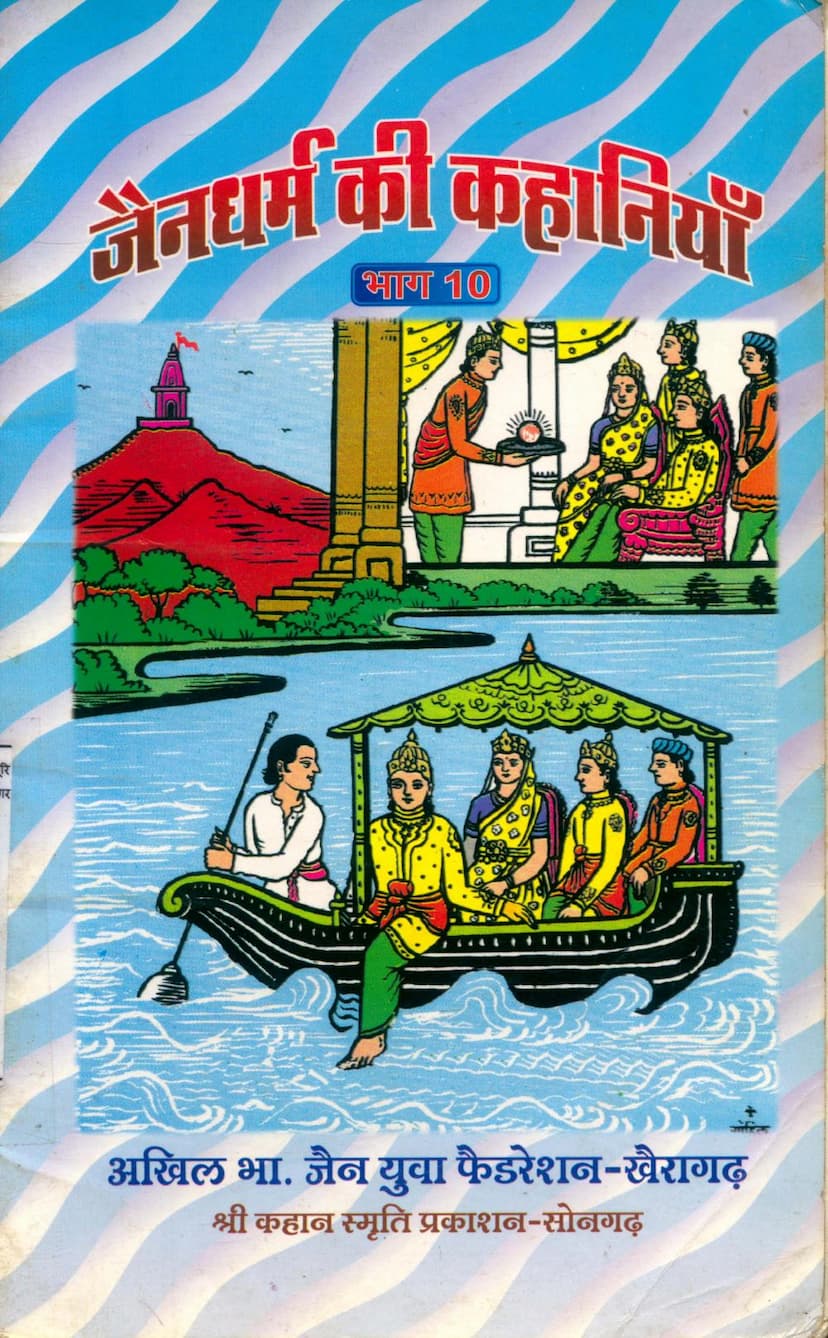Jain Dharm Ki Kahaniya Part 10
Added to library: September 1, 2025

Summary
This document is the tenth part of a Jain story series titled "Jain Dharm Ki Kahaniya Part 10," authored by Rameshchandra Jain and published by Akhil Bharatiya Jain Yuva Federation. The book is part of the "Shrimati Dhudhibai Khemraj Gidiya Granthmala."
The book contains 17 mythological stories and 7 motivational anecdotes written in a simple and understandable style, authored by Brahmachari Harilal Jain. Pandit Rameshchandra Jain Shastri of Jaipur edited and proofread the content.
The publication is supported by various patrons and organizations, with a list of contributors provided. The introductory sections also include a brief biography of Shri Khemraj Gidiya, whose family's generosity supports the Granthmala.
The content of the book includes several stories and discourses:
- "Zara Sa Avivek (Subhaum Chakravarti)": This story illustrates the consequences of a slight lapse in judgment, leading to the downfall of a powerful king.
- "Raja Madhu Ko Vairagya": This narrative details how King Madhu attained detachment from worldly life after facing defeat and contemplating the impermanence of worldly possessions and the importance of righteousness.
- "Mathura Mein Saptarishi": This story recounts the arrival of seven great ascetics (Saptarishi) in Mathura, their divine intervention in alleviating a plague, and their teachings to the populace and King Shatrughna.
- "Mathura Mein Chatrumas Aur...": This section continues the narrative of the Saptarishi in Mathura, highlighting their unique spiritual practices during Chaturmas and the exemplary devotion of a merchant, Arhadatt Seth.
- "Aapas Mein Dharm Charcha": This section features a philosophical discussion between Queen Chellana and her son Abhaykumar, emphasizing the importance of righteousness and equanimity in facing adversities.
- "Karma Ko Krish Kare So Krishna": This story uses the example of Lord Krishna to illustrate the power of inner strength and righteousness in overcoming obstacles.
- "Akampanacharya Ki Adigta": This story highlights the steadfastness and devotion of Acharya Akampana and Vishnukumar in protecting Jain monks.
- "Siddh Bhagwan Ki Aatmakatha": This section describes the spiritual journey of a soul named Siddh Kumar, from suffering in the Nighoda state to attaining liberation.
- "Kabhi Socha! Tumhara Parbhav Mein Kya Hoga?": This piece encourages introspection about one's spiritual journey and the importance of recognizing the soul's true nature.
- "Jo Hota Hai Sab Achhe Ke Liye": This story uses illustrative examples and a parable to convey the philosophy that whatever happens is for the good.
- "Hasmukh Ki Fariyad": This is a story about a student named Hasmukh and his interaction with his teacher regarding a verbal insult, used to explain the principles of Jain philosophy concerning soul and matter.
- "Do Bhai, Shanti Ki Shodh Mein": This story emphasizes that true peace and refuge are found within the soul, not in external circumstances.
- "Dhanya Hai Vah Putra Aur...": This story highlights the profound renunciation of an eight-year-old prince and his mother's virtuous acceptance.
- "Amrakumar Ki Amar Kahani": This is a dramatized story about a boy named Amarkumar who, through his faith in the Panch Parmesthi mantra, is saved from sacrifice.
- "Jeevan Ka Dhyeya": This section presents a discussion among friends about their life goals, with the ultimate conclusion that the true aim of life is self-realization and spiritual liberation.
- "Sukhi Kaun?": This parable explains that true happiness lies in contentment with one's true self, not in the acquisition of external objects.
- "Sarvadhik Mahatvapurna Kaun?": This story uses the analogy of an oil lamp to illustrate the qualities of a true servant and the significance of the soul.
- "Prerak Prasang": This section contains several short motivational stories, including:
- Sita's renunciation and attainment of higher spiritual states.
- Luv and Kush's renunciation and attainment of Kevalgyan.
- King Shrenik's transformation after witnessing the equanimity of Muni Yashodhar.
- A lion receiving spiritual guidance and attaining Samyakdarshan, foretelling its future as Tirthankar Mahavir.
- Neminath and Rajul's renunciation and path to spiritual attainment.
- The realization of the soul's inherent divine nature.
- The power of divine teachings in overcoming worldly attachments.
- "Hamare Prakashan": This is a list of other books published by the Federation.
- "Hamare Prerna Khoj": This section provides a tribute and biographical sketch of Brahmachari Harilal Amrutlal Mehta, the author of many of the stories in the series, highlighting his literary contributions and spiritual dedication.
The book aims to educate readers about Jain principles, ethics, and spiritual paths through engaging narratives and profound philosophical insights.